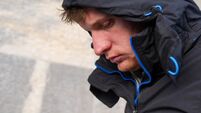The women’s volunteer army that kept Irishmen clothed and fighting fit on the western front
The civilian voluntary effort to support the Irish troops at home and at the front was co-ordinated by a joint executive committee of people from the British Red Cross Society’s Co Dublin branch and the Irish district of the St John Ambulance Association.
This joint committee co-ordinated the voluntary work in the provinces of Leinster, Munster and Connacht. Ulster’s voluntary committee decided to operate separately.
Before the war, a network of voluntary aid units had been set up in Ulster in expectation of civil war if Home Rule was imposed.
Voluntary aid groups or detachments of men and women were raised on a county system. These became known as Voluntary Aid Detachments, or VADs for short.
After enrolling as a VAD, men and women had to pass a course in first aid. Women were taught home nursing, hygiene and cooking. They also worked in hospital wards as nurses’ aids.
With the massive numbers of war casualties coming to Ireland, the demand for hospitals grew. Throughout the war, the joint committee, based at Dawson Street, Dublin, was responsible for organising and equipping 23 auxiliary hospitals and nursing homes spread throughout Leinster, Munster and Connaught.
In most instances, local committees were appointed to raise money through voluntary contributions to equip and manage these hospitals. Many volunteers worked in the auxiliary hospitals as ambulance personnel and nurses’ aids.
Trained nurses were deemed too valuable to waste, so much of the menial and routine hospital work was carried out by the female VADs.
One such volunteer described her work: long hours, much scrubbing and carrying of meals, being at the beck and call of an uncertain tempered staff nurse, and other menial chores, with plentiful blame for what they had not done.
Not all VAD work involved working as ambulance personnel or as nurses’ aids in hospitals. Red Cross workrooms were set up in Merrion Square, Dublin. The work that the women carried out here was mainly cutting and making garments such as pyjamas, pants and vests for soldiers at home and at the front.
Some 300 female volunteers worked long hours and produced approximately 50,000 garments along with more than 20,000 pairs of socks and 10,000 mufflers.
Regular appeals were made for supplies of “necessaries and comforts to the troops at the front and various field, base and general hospitals in France”. Special appeals were made for items such as nightshirts that were urgently needed.
The appeal notice requested that all socks and grey shirts should be washed before sending them to the depot at Dawson Street.
Sending a bag of dirty linen with smelly socks was not appreciated by the ladies at the clothing depot there.
In December 1916, the Irish War Hospitals Supply Depot was set up at Merrion Square.
Here, volunteers made dressings and bandages such as papier maché surgical applications and sphagnum moss dressings. Due to the war, one of the first articles to become scarce was cotton wool.
Because of its excellent absorption properties, sphagnum moss proved an excellent substitute. Some women spent many a cold winter’s afternoon gathering moss in the Dublin Mountains. Gathered from the Irish bogs, the moss was sterilised, dried and sent to sub-depots throughout Ireland. The central depot for the sphagnum moss collection in Dublin was the Royal College of Science in Merrion Street, now the Department of the Taoiseach.
Many of the Irish regiments such as the Royal Dublin Fusiliers, the Royal Munster Fusiliers, the Leinster Regiment and Connaught Rangers had volunteer societies who set up comforts for the troop committees in their respective recruiting areas. The Royal Irish Fusiliers looked for “discarded razors, shaving brushes, strops and warm waistcoats” which were to be sent to an address in Armagh.
Mrs Allen of the United Irishwomen collected for the 10th Cycling Company stationed at the Curragh.
A bureau was set up at 45 Kildare Street to accept donations of “cigarettes, pipe tobacco, matches and chocolate for the various battalions of the Dublin Fusiliers serving at the front”.
The office was mainly run by women. In August 1914, the Committee of the Dublin Women’s Unionist Club held a meeting at its offices in Leinster Street.
They decided to work for the men serving with the Dublin Fusiliers through “the collection and dispatch of a large quantity of newspapers, magazines and books to the battalions of the regiment serving with the Expeditionary Force in France and Flanders”.
Apparently the ladies thought the intellectual needs of the men more important than their physical needs. The Dublin Women’s Unionist Club was not the only group of women which worked for the Irishmen in the trenches. During the war, at the north Co Dublin convent in Baldoyle, the Irish Sisters of Charity took to making shirts for the British army. However, unlike their unionist sisters, there was nothing charitable about this work as it was strictly business.
At the end of the war, when there was no more need for army shirts, the nuns turned their skills to crochet work, knitwear and manufacturing of silk garments.
The majority of these young ladies who volunteered for service were in their late teens to mid-twenties. Some of them, like Mary Martin and Rosemary Savage, served near the front. Others like Monica Roberts served their cause at home. Mary Martin came from the Dublin timber merchants’ family of T and C Martin.
At the age of 22, she served as a VAD in Malta where she tended many of Gallipoli’s wounded. Her brother, Capt Charlie Martin, was killed serving with the Dublin Fusiliers in Salonika in 1915.
Before she left for a field hospital in France, Rose Mary Savage lived at Cushendall, Co Antrim, where she and her mother ran fundraising events in aid of the 13th Royal Irish Rifles.
Monica Roberts and her friend used to go round the parish halls of south county Dublin performing song recitals and gathering money so they could buy sweets, cigarettes and gloves for the Dublin Fusiliers in France. She wrote to many of the men, some of whom were her own age. In their loneliness, some of the younger soldiers adopted Monica as their sweetheart. Sophia Violet Barrett was born in Ballintava, Co Galway. She joined the Carrickmines and Kingstown branch of the VADs and volunteered for service in Rouen and Abbeyville in France.
By the end of the war, 83 women’s Voluntary Aid Detachment units consisting of 2,927 members had been established throughout Leinster, Munster and Connaught, the majority being in Dublin.
Moreover, the volunteer women workers in the Irish (Leinster, Munster and Connaught) War Hospital Supply Depot numbered approximately 6,000. In Ulster by the end of May 1914, the Ulster VADs had 3,520 members throughout the province.
Mary Martin returned from the war to set up the Medical Missionaries of Mary. She died in Our Lady of Lourdes Hospital in Drogheda in 1975. Monica Roberts from Stillorgan married and reared her family on the banks of the Liffey. She died in 1974.
Rose Mary Savage married an Irish soldier in India and came home to live in Bandon. She died in 1983 at the age of 90.
Sophia Violet Barrett was killed while returning to the front from leave aboard the RMS Leinster on October 10, 1918, one month before the war ended.
Tom Burke
Ayrfield Road
Ayrfield
Dublin 13











